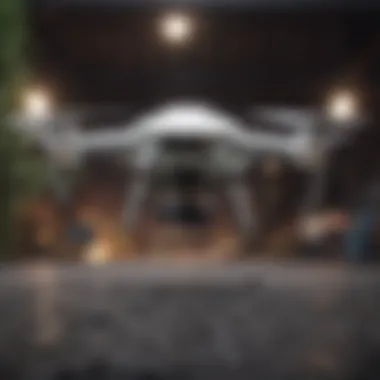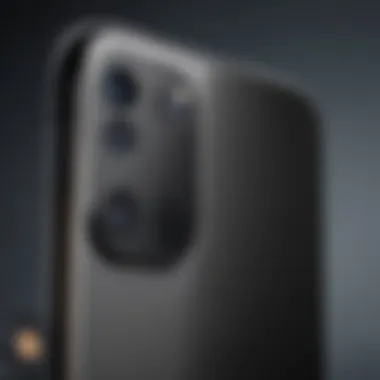Unveiling the DJI Mini 3: A Detailed Examination of its Cutting-Edge Specifications


Product Overview
The DJI Mini 3 drone, the latest innovation from the renowned brand DJI, is a beacon of advanced technology in the realm of aerial photography and videography. Boasting a plethora of cutting-edge features, this drone promises an unparalleled and seamless flying experience to users enthralled by the world of drone technology. From its compact design to its powerful performance capabilities, the DJI Mini 3 stands as a testament to DJI's commitment to excellence in drone engineering.
Performance and User Experience
In terms of performance benchmarks, the DJI Mini 3 sets a new standard in the world of compact drones. With enhanced flight stability and precise controls, this drone offers smooth maneuverability and captivating aerial shots. The user interface and software capabilities are intuitively designed, catering to both beginners and experienced drone pilots alike. User experiences and feedback herald the Mini 3 as a game-changer, delivering exceptional image quality and flight performance that exceed expectations on every front.
Comparison with Previous Models or Competitors
Compared to its predecessors, the DJI Mini 3 showcases significant advancements and improvements in every aspect. From enhanced camera resolution to extended flight time, this drone excels on all fronts, setting itself apart as a standout in the drone market. A competitive analysis with other similar products reveals the DJI Mini 3's unrivaled value proposition, offering a perfect blend of performance, portability, and innovative features that elevate the drone flying experience to new heights.
Tips and Tricks
For those eager to optimize their DJI Mini 3 experience, a host of how-to guides and tutorials are available to unlock the drone's full potential. Discover hidden features and functionalities that can enhance your aerial photography and video capabilities. Additionally, troubleshoot common issues effortlessly with detailed guidance, ensuring a seamless and enjoyable drone piloting experience every time.
Latest Updates and News
Stay abreast of the latest developments in the DJI Mini 3 universe with recent software updates, introducing new features and enhancements to elevate your drone flying experience. Delve into industry news and rumors surrounding upcoming products, keeping you informed and engaged with the ever-evolving world of drone technology. Keep an eye out for events and announcements from DJI, offering insights into the future of drone innovation and technology.
Introduction
As we embark on the journey of exploring the DJI Mini 3, a drone that has caused quite a stir in the tech community, it is essential to understand the significance of our starting point - the Introduction. In this pivotal section of the article, we lay the groundwork for a comprehensive analysis of the DJI Mini 3 and its myriad specifications. By delving into the nuances of this drone and peeling back its layers, we aim to equip our readers with a holistic understanding of what sets this model apart in the ever-evolving landscape of unmanned aerial vehicles.
The Introduction serves as the gateway to unlocking the potential of the DJI Mini 3, offering a sneak peek into the intricate details that make this drone a standout choice for aerial enthusiasts and professional photographers alike. By setting the stage for what is to come, we provide a roadmap that guides readers through the twists and turns of the Mini 3's capabilities, ensuring that no stone is left unturned in our exploration.
Moreover, in this burgeoning field of drone technology, where innovation reigns supreme, the Introduction acts as a compass, orienting our readers towards the key features and functionalities that define the DJI Mini 3. From its advanced camera specifications to its effortless flight performance, each aspect covered in this section paves the way for a deeper dive into the world of drone piloting, shedding light on the artistry and engineering prowess encapsulated within this compact yet powerful device.
By unraveling the layers of the DJI Mini 3 in the Introduction, we aim to not only inform but also inspire our audience - igniting a sense of curiosity and wonder that propels them further into the realms of technological innovation. Stay tuned as we embark on this exhilarating journey through the intricate web of specifications that make the DJI Mini 3 a force to be reckoned with in the realm of drones.
Overview of DJI Mini
The 'Overview of DJI Mini 3' section in this article serves as a foundational element in unraveling the intricacies of this highly anticipated drone. Understanding the design, camera, flight performance, and remote controller features of the DJI Mini 3 establishes a framework for a comprehensive analysis. By delving into each aspect, readers can grasp the innovation and technological advancements embedded within this cutting-edge device.
Design and Build
Compact and Lightweight Construction
Discussing the compact and lightweight construction of the DJI Mini 3 unveils a pivotal aspect of its design ethos. The meticulous attention to detail in crafting a drone that is both compact and lightweight bears testimony to DJI's commitment to portability and ease of use. The utilization of premium materials ensures durability without compromising on weight, making it an ideal choice for users seeking a portable yet robust drone. The compact design enables effortless transportation, while the lightweight construction enhances maneuverability during flight, offering users a seamless and enjoyable drone piloting experience.
Material Composition


Exploring the material composition of the DJI Mini 3 sheds light on the careful selection of materials to enhance performance and longevity. The choice of high-quality materials not only contributes to the overall durability of the drone but also plays a crucial role in optimizing its flight characteristics. The blend of lightweight yet durable components ensures a balance between structural integrity and aerodynamic efficiency, making the DJI Mini 3 a standout choice in its class.
Propeller Design
The propeller design of the DJI Mini 3 represents a key engineering feat aimed at maximizing flight performance. The innovative design of the propellers, characterized by their efficiency and stability, significantly impacts the drone's aerodynamic properties. The carefully crafted propeller design minimizes noise levels, enhances flight stability, and improves overall control, culminating in an unparalleled flying experience for users.
Camera Specifications
Sensor Size and Type
Diving into the sensor size and type of the DJI Mini 3 reveals a critical aspect of its imaging capabilities. The incorporation of advanced sensors with optimal size and type ensures high-quality image capture, allowing users to achieve stunning aerial photography and videography. The sensor's efficiency in low-light conditions and its ability to capture intricate details contribute to the drone's overall imaging prowess, setting a new standard for drone cameras in its category.
Resolution and Video Capabilities
Exploring the resolution and video capabilities of the DJI Mini 3 unveils the power of its imaging technology. With impressive resolution settings and video recording capabilities, users can capture crystal-clear footage with vibrant colors and sharp detail. The drone's ability to shoot in various modes and resolutions caters to a wide range of creative needs, empowering users to unleash their artistic vision and capture breathtaking moments from unique perspectives.
Photography Modes
The diverse photography modes offered by the DJI Mini 3 broaden the horizons of aerial photography enthusiasts. From panoramic shots to dynamic tracking modes, the drone provides innovative features that enhance the creative potential of its users. The availability of automated modes simplifies the photography process, allowing users to focus on composition and creativity while the drone takes care of the technicalities, resulting in professional-quality shots with ease.
Flight Performance
Speed and Agility
The speed and agility of the DJI Mini 3 redefine the boundaries of drone performance. With impressive speed capabilities and agile maneuverability, the drone enables dynamic flying experiences that cater to both recreational and professional users. The drone's swift response to commands and nimble flight characteristics offer users unparalleled control and precision, setting it apart as a top contender in the realm of compact drones.
Wind Resistance
Exploring the wind resistance capabilities of the DJI Mini 3 underscores its reliability in adverse weather conditions. The drone's ability to maintain stability and control in windy environments enhances user confidence and expands the range of flying scenarios. Advanced aerodynamic features work in synergy to counter turbulence and gusts, ensuring smooth flights and steady aerial footage even in challenging weather conditions.
Battery Life
The impressive battery life of the DJI Mini 3 is a game-changer for drone enthusiasts seeking extended flying sessions. With prolonged flight times per charge cycle, users can immerse themselves in aerial exploration without the constraint of frequent recharging. The optimally designed battery system not only enhances user experience but also prolongs the lifespan of the drone, making it a reliable companion for extended adventures in the skies.
Remote Controller Features
Range and Connectivity
The range and connectivity features of the DJI Mini 3's remote controller elevate the user experience to new heights. With extended range capabilities and reliable connectivity protocols, users can pilot the drone with confidence and precision, even over considerable distances. The seamless connection between the remote controller and drone ensures responsive control and seamless data transmission, fostering a seamless piloting experience for users of all skill levels.
User Interface
The user interface of the DJI Mini 3's remote controller embodies simplicity and functionality, catering to users' varying needs and preferences. Intuitive controls, ergonomic design, and a user-friendly interface facilitate effortless navigation and seamless operation, enabling users to focus on capturing stunning aerial footage without distraction. The thoughtfully designed user interface enhances user engagement and interaction, fostering a deeper connection between the pilot and the drone.


Additional Functions
The array of additional functions integrated into the DJI Mini 3's remote controller expands the possibilities of drone piloting. From customizable settings to advanced flight modes, the remote controller offers a plethora of features that empower users to explore new creative avenues and flight capabilities. The innovative functions not only enhance user convenience and control but also pave the way for dynamic and innovative drone piloting experiences, setting a new benchmark in the realm of compact drone controllers.
This detailed exploration of the DJI Mini 3 encapsulates its innovative features, advanced capabilities, and user-centric design, paving the way for a deeper understanding of this groundbreaking drone.
Advanced Features
When delving into the intricate details of the DJI Mini 3, it's crucial to highlight the section on Advanced Features. These elements are pivotal in shaping the drone's performance and user experience, setting it apart from its competitors. By understanding the nuances of Advanced Features, enthusiasts and professionals alike can appreciate the innovative technologies integrated into this cutting-edge drone.
Obstacle Avoidance
Sensor Technology
In the realm of drone technology, Sensor Technology plays a critical role in enhancing safety and flight precision. The DJI Mini 3 incorporates advanced sensor technologies that enable it to detect and avoid obstacles in its flight path. These sensors continually scan the surroundings, providing real-time data to the drone's intelligent system. This feature is instrumental in preventing collisions and ensuring smooth flight operations. Moreover, the precision and accuracy of the sensors make the DJI Mini 3 a reliable choice for enthusiasts and professionals seeking a seamless flying experience.
Collision Avoidance System
Complementing the Sensor Technology, the Collision Avoidance System is a key component that fortifies the DJI Mini 3's safety measures. This system utilizes sophisticated algorithms to analyze data from the sensors and proactively steer the drone away from potential obstacles. By leveraging cutting-edge technology, the Collision Avoidance System enhances the drone's ability to navigate complex environments with ease. While like any technology, it may have limitations, its overall contribution to ensuring a secure and stable flight experience cannot be overstated.
Intelligent Flight Modes
Waypoints
Within the DJI Mini 3's array of Intelligent Flight Modes, Waypoints stand out as a feature that offers enhanced control and automation. This mode allows users to predefine a flight path by setting specific waypoints on a map. The drone then autonomously follows this route, capturing footage or images with precision. By leveraging Waypoints, users can create dynamic and complex aerial shots effortlessly, making it an invaluable tool for photographers and videographers looking to achieve professional-grade content.
Follow Me
The Follow Me mode is another notable addition to the DJI Mini 3's repertoire of Intelligent Flight Modes. In this mode, the drone autonomously tracks and follows a designated subject, maintaining a consistent distance and framing the subject accurately. Whether for capturing action shots or showcasing outdoor activities, Follow Me adds a layer of dynamism to aerial photography and videography. However, users should be mindful of surroundings and potential obstacles to ensure a seamless Follow Me experience.
Point of Interest
For aerial enthusiasts seeking to capture captivating footage of a specific location or object, the Point of Interest mode proves to be a valuable asset. By selecting a point of interest on the map, users can command the DJI Mini 3 to orbit around this focal point while keeping it centered in the frame. This mode adds a cinematic quality to drone footage, introducing a professional touch to aerial videography. Though engaging, users must exercise caution when setting the point of interest to avoid hindrances during flight.
Safety and Security
Return-to-Home Function
The Return-to-Home Function serves as a fail-safe mechanism for the DJI Mini 3, ensuring its safe return to the take-off point in unforeseen circumstances. This feature automatically triggers when the drone's battery reaches a critical level or when connection signal weakens, guiding the drone back to its initial position. This not only safeguards the drone from potential losses but also instills confidence in users, knowing that their device can autonomously navigate back to safety.
Geo-Fencing


Integrating Geo-Fencing technology, the DJI Mini 3 provides users with the ability to define virtual boundaries for their drone's flight. By setting geographical restrictions, operators can prevent the drone from straying into restricted areas or airspace. This feature promotes responsible flying practices and compliance with aviation regulations, enhancing overall safety during flight operations. However, users should regularly update Geo-Fencing parameters to align with current regulations and airspace restrictions.
AirSense Technology
Designed to elevate situational awareness, Air Sense Technology equips the DJI Mini 3 with the capability to detect nearby aircraft and relay crucial information to the operator. This technology leverages ADS-B signals from nearby airplanes and helicopters, alerting users of potential air traffic in the vicinity. By incorporating AirSense, DJI reinforces safety protocols, enabling operators to make informed decisions and prioritize airspace safety. Despite its reliability, users should remain vigilant and not solely depend on AirSense alerts, maintaining a proactive approach to drone operation and safety.
Comparison with Previous Models
In this section of the article, we delve into the crucial aspect of comparing the DJI Mini 3 with its predecessor, the DJI Mini 2. This comparison holds substantial significance in understanding the advancements and refinements that the latest model brings to the table. By scrutinizing the differences and enhancements between the two models, readers can grasp the evolution and innovation within DJI's Mini series. Exploring the changes from the Mini 2 to the Mini 3 provides valuable insights into the iterative development and technological progress inherent in DJI's drone offerings.
DJI Mini vs. DJI Mini
Notable Improvements
A focal point of interest in the upgrade from DJI Mini 2 to Mini 3 lies in the notable improvements integrated into the latest iteration. The Mini 3 showcases advancements in key areas such as camera performance, flight capabilities, and user experience. The enhanced sensor technology, improved resolution, and additional photography modes in the Mini 3 elevate the user's aerial imaging experience to new heights compared to its predecessor. These enhancements not only enhance the overall flight performance but also pave the way for more cinematic and creative possibilities for drone enthusiasts and professionals.
Key Differences
Distinguishing the DJI Mini 3 from its precursor, the DJI Mini 2, are several key differences that cater to varying user preferences and needs. One of the standout disparities is the introduction of advanced safety features in the Mini 3, such as an upgraded collision avoidance system and enhanced return-to-home function. These additions enhance the drone's reliability and security during flights, assuring users of a safer and more controlled aerial experience. Furthermore, the key differences extend to flight stability, connectivity options, and overall handling, offering users a spectrum of improvements to elevate their drone piloting experience.
Price Variance
Unveiling the price variance between the DJI Mini 2 and Mini 3 provides insight into the value proposition each model offers. Understanding the cost differential between these models allows consumers to evaluate the added benefits and features they receive with the Mini 3 in comparison to its predecessor. The value proposition of the Mini 3 encompasses a comprehensive package of upgraded functionalities and performance enhancements that justify the price variance. By examining the price variance in detail, consumers can make informed decisions based on the value and utility the DJI Mini 3 delivers in relation to its pricing, ensuring a tailored investment in line with their requirements and expectations.
Availability and Release Date
In the realm of technological wonders that the DJI Mini 3 epitomizes, the Availability and Release Date stand as pivotal junctures, foreseeing the fusion of innovation and market anticipation. The unveiling of this drone unleashes a ripple effect that transcends beyond mere product launch dates. Such moments encapsulate the culmination of meticulous planning, engineering prowess, and consumer fervor.
The significance of the Release Date resonates deeply within the tech community, signaling the dawn of a new era in aerial imaging and drone capabilities. For Apple aficionados, tech enthusiasts, and industry professionals alike, the reveal of the DJI Mini 3's availability serves as a beacon, guiding them towards the next frontier of drone technology.
Delving into the specifics of Availability, one must dissect the intricate web of global logistics, production timelines, and supplier networks that converge to deliver this marvel into the eager hands of consumers worldwide. The meticulous orchestration required to synchronize the availability across diverse regions underscores the elaborate dance between supply chain dynamics and consumer demand.
Beyond the sheer temporal aspect, the Release Date encapsulates a symphony of expectations, promises, and technological marvels. It heralds not just the arrival of a new product but also the embodiment of DJI's ethos - pushing boundaries, redefining standards, and fostering a community of aerial enthusiasts united by a common passion for flight and innovation.
As the curtain rises on the Availability and Release Date of the DJI Mini 3, it invites us to partake in a journey marked by anticipation, excitement, and unwavering technological marvel. In this ever-evolving landscape of drones and aerial exploration, these moments of release transcend mere calendar dates, becoming milestones in a narrative woven with threads of creativity, ingenuity, and the relentless pursuit of excellence.
Conclusion
In this section, we consolidate the wealth of information presented throughout this comprehensive exploration of the DJI Mini 3 drone's specifications. Conclusions drawn from detailed analysis are imperative for readers aiming to make informed decisions in potential purchase considerations. Delving into the summary of the DJI Mini 3 characteristics and capabilities, one can grasp the significance of each aspect in the broader context of consumer drones.
To begin, capturing the essence of the Mini 3's innovative design and build is crucial. The compact dimensions and lightweight construction not only showcase DJI's commitment to portability but also underscore the advancements made in material composition and propeller design. Understanding these nuances ensures a user-friendly experience and lays the foundation for optimal performance during flight.
Transitioning to the realm of camera specifications, the Mini 3's sensor size and type play a pivotal role in determining the quality of aerial imagery captured. The emphasis on resolution and video capabilities speaks to the device's versatility, catering to both amateur photographers and professional videographers alike. Additionally, exploring the various photography modes available sheds light on the creative potential this drone offers to enthusiasts of aerial imaging.
Moving on to flight performance, the Mini 3's speed, agility, and wind resistance are integral aspects to consider when assessing its capabilities. The extended battery life further enhances the overall flying experience, allowing users to maximize their time in the air without frequent interruptions for recharging. These features underscore DJI's commitment to providing a seamless and reliable aerial platform for users of all skill levels.
Moreover, delving into the remote controller features elucidates the range, connectivity options, user interface design, and additional functions that elevate the piloting experience. The robust connectivity options ensure a stable link between the drone and controller, while the intuitive user interface simplifies navigation and control, enhancing the overall flying experience. The incorporation of additional functions adds value and functionality, catering to a diverse range of user preferences.
In essence, the conclusion section encapsulates the essence of the DJI Mini 3 drone's specifications, highlighting its key features and capabilities. By synthesizing the information presented in preceding sections, readers can make informed decisions regarding the suitability of this drone for their specific needs and preferences. Ultimately, the conclusive insights provided aim to empower readers with the knowledge necessary to navigate the complexities of the consumer drone market effectively.



